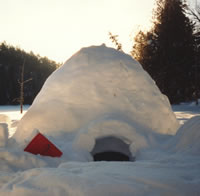Sleeping warm on
a frigid, Michigan camping trip requires more than just a
cold-weather sleeping bag. Just as a building is heated only
by it's furnace, your sleeping bag will not warm up without
your heat-producing body inside it. And as with your home,
there are several ways you can both increase the amount of
heat generated by your body and reduce the amount of heat
that escapes from your sleeping bag.
A properly sealed sleeping bag will capture
more of your body's heat just as tightly sealed windows and
doors slow the loss of heat from your home. In addition to
eight inches or more of insulation, a well-designed cold-weather
bag will have a sculptured hood that seals well around the
face and creates a small hole for you to expel moisture-laden
breath.
The side-entry zipper as well as the area
around the shoulders should both be sealed against heat loss
by thickly-insulated, draft tubes. These critical baffles
prevent body heat from being pumped out of the bag as you
move around during the night.
If your bag lacks enough loft (thickness)
to keep you warm all night, consider loosely draping another
sleeping bag over it. To keep the second bag from sliding
off during the night, sew a few, well-place shoelace ties
on each bag to keep them aligned.
A fleece or wool sweater draped around
your shoulders can serve as an improvised heat baffle. To
prevent heat from escaping through an unprotected zipper,
simply rotate the bag sideways until you're almost sleeping
on the zipper.
During colder periods, a full-length, 1/2-inch-thick,
closed-cell foam pad is essential. Many experienced winter
campers add a second 3/4-length pad for extremely cold temperatures.
You may want to avoid using open-cell foam as it tends to
absorb moisture.
Air mattresses are popular too, but make
sure yours is a design that incorporates open-cell foam in
the interior. If not, place a closed-cell foam pad on top
of it to prevent air currents within the air mattress from
sucking away your body heat.
Even if you're sleeping on a cot or a hammock,
you'll still need a pad to insulate you from the cold air
circulating underneath you. Keep in mind the portion of the
sleeping bag that is compressed underneath you will have little
if any insulation value.
Sleeping in sweat- or rain-dampened clothing
is a sure way to wake up cold later in the night. To avoid
this problem, always change into dry clothing before you retire
for the evening. Since the layer next to your skin is the
most important one, make sure it's a non-cotton wicking fabric
like polypropylene. Never wear cotton, especially against
your skin, as it is a magnet for moisture.
During colder periods, wear additional
synthetic-insulated layers of clothing to extend the comfort
range of your sleeping bag. Adding additional layers will
only work if they fit loosely on you and in the bag itself.
Always wear a hat or two since an uncovered
head can allow 50 to 75 percent of your body heat to escape.
In extremely cold temperatures, I like to wear two warm hats
over a thin, polypropylene balaclava (or facemask). Worn directly
against your skin, a facemask wicks chilling moisture away
from your head while at the same time protecting your face
and neck, two areas where a hat comes up short.
Even if the rest of your body is nice and
warm in your sleeping bag, if your feet are cold, you'll more
then likely have difficulty sleeping. To make sure your feet
are warm all night, wear two pair of thick, dry socks and
a pair of thickly-insulated sleeping booties.
In the hours before you retire to your
bag, eat a good, hearty meal to stimulate the digestive process.
This will help the body generate heat well into the night.
Drinking plenty of liquids, preferably hot ones, will warm
you up and help stave off cold-inducing hypothermia.
To warm your bag up quicker, eat some high-calorie
snacks and sip some water just before entering your sleeping
bag. Some winter campers warm up their bags by taking one
or two tightly-sealed water bottles filled with hot water
into their bags with them. A brisk walk or some light calisthenics
are two more ways to quickly warm up just as you climb into
your bag. Entering your sleeping bag when you're thoroughly
chilled will only predispose you to a cold, sleepless night.
Armed with the right sleeping system as
well as an understanding of how to use it properly, you're
much more likely to enjoy your next winter camping trip in
the Michigan.
|


